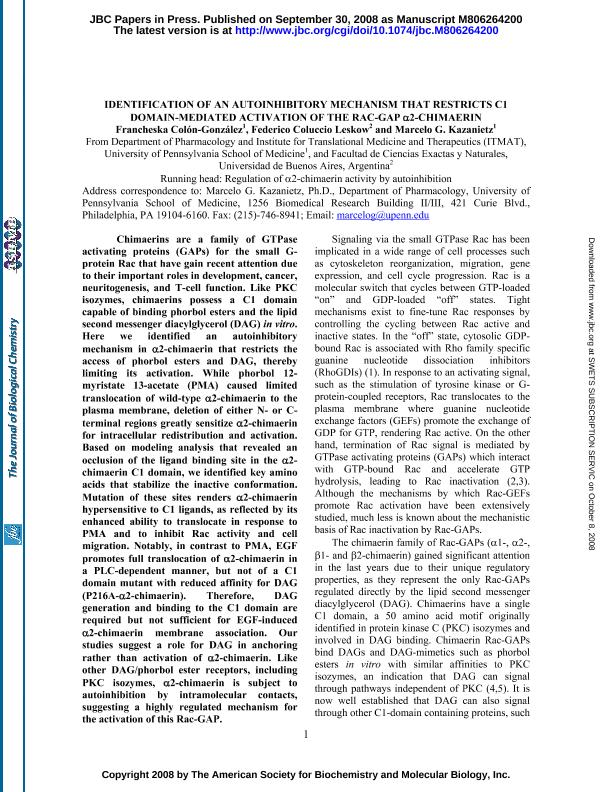Mostrar el registro sencillo del ítem
dc.contributor.author
Colón González, Francheska
dc.contributor.author
Coluccio Leskow, Federico

dc.contributor.author
Kazanietz, Marcelo Gabriel

dc.date.available
2019-03-08T20:03:09Z
dc.date.issued
2008-12
dc.identifier.citation
Colón González, Francheska; Coluccio Leskow, Federico; Kazanietz, Marcelo Gabriel; Identification of an autoinhibitory mechanism that restricts C1 domain-mediated activation of the Rac-GAP α2-chimaerin; American Society for Biochemistry and Molecular Biology; Journal of Biological Chemistry (online); 283; 50; 12-2008; 35247-35257
dc.identifier.issn
0021-9258
dc.identifier.uri
http://hdl.handle.net/11336/71281
dc.description.abstract
Chimaerins are a family of GTPase activating proteins (GAPs) for the small G-protein Rac that have gained recent attention due to their important roles in development, cancer, neuritogenesis, and T-cell function. Like protein kinase C isozymes, chimaerins possess a C1 domain capable of binding phorbol esters and the lipid second messenger diacylglycerol (DAG) in vitro. Here we identified an autoinhibitory mechanism in α2-chimaerin that restricts access of phorbol esters and DAG, thereby limiting its activation. Although phorbol 12-myristate 13-acetate (PMA) caused limited translocation of wild-type α2-chimaerin to the plasma membrane, deletion of either N- or C-terminal regions greatly sensitize α2-chimaerin for intracellular redistribution and activation. Based on modeling analysis that revealed an occlusion of the ligand binding site in the α2-chimaerin C1 domain, we identified key amino acids that stabilize the inactive conformation. Mutation of these sites renders α2-chimaerin hypersensitive to C1 ligands, as reflected by its enhanced ability to translocate in response to PMA and to inhibit Rac activity and cell migration. Notably, in contrast to PMA, epidermal growth factor promotes full translocation of α2-chimaerin in a phospholipase C-dependent manner, but not of a C1 domain mutant with reduced affinity for DAG (P216A-α2- chimaerin). Therefore, DAG generation and binding to the C1 domain are required but not sufficient for epidermal growth factor-induced α2-chimaerin membrane association. Our studies suggest a role for DAG in anchoring rather than activation of α2-chimaerin. Like other DAG/phorbol ester receptors, including protein kinase C isozymes, α2-chimaerin is subject to autoinhibition by intramolecular contacts, suggesting a highly regulated mechanism for the activation of this Rac-GAP.
dc.format
application/pdf
dc.language.iso
eng
dc.publisher
American Society for Biochemistry and Molecular Biology

dc.rights
info:eu-repo/semantics/openAccess
dc.rights.uri
https://creativecommons.org/licenses/by-nc-sa/2.5/ar/
dc.subject
Chimaerins
dc.subject
Dag
dc.subject
Rac
dc.subject.classification
Otras Ciencias Biológicas

dc.subject.classification
Ciencias Biológicas

dc.subject.classification
CIENCIAS NATURALES Y EXACTAS

dc.title
Identification of an autoinhibitory mechanism that restricts C1 domain-mediated activation of the Rac-GAP α2-chimaerin
dc.type
info:eu-repo/semantics/article
dc.type
info:ar-repo/semantics/artículo
dc.type
info:eu-repo/semantics/publishedVersion
dc.date.updated
2019-02-12T17:07:41Z
dc.journal.volume
283
dc.journal.number
50
dc.journal.pagination
35247-35257
dc.journal.pais
Estados Unidos

dc.journal.ciudad
Bethesda
dc.description.fil
Fil: Colón González, Francheska. University of Pennsylvania; Estados Unidos
dc.description.fil
Fil: Coluccio Leskow, Federico. Consejo Nacional de Investigaciones Científicas y Técnicas; Argentina. Universidad de Buenos Aires. Facultad de Ciencias Exactas y Naturales; Argentina
dc.description.fil
Fil: Kazanietz, Marcelo Gabriel. University of Pennsylvania; Estados Unidos
dc.journal.title
Journal of Biological Chemistry (online)

dc.relation.alternativeid
info:eu-repo/semantics/altIdentifier/url/http://www.jbc.org/content/283/50/35247
dc.relation.alternativeid
info:eu-repo/semantics/altIdentifier/doi/https://dx.doi.org/10.1074/jbc.M806264200
Archivos asociados
